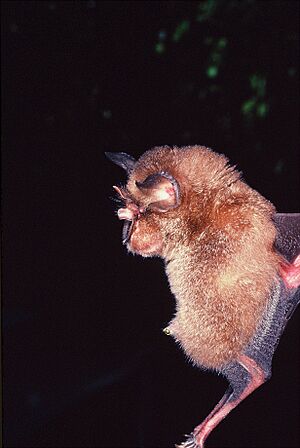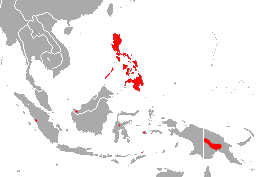Arcuate horseshoe bat facts for kids
Quick facts for kids Arcuate horseshoe bat |
|
|---|---|
 |
|
| Conservation status | |
| Scientific classification | |
| Genus: |
Rhinolophus
|
| Species: |
arcuatus
|
 |
|
| Arcuate horseshoe bat range | |
The arcuate horseshoe bat (Rhinolophus arcuatus) is a type of bat. It belongs to the Rhinolophidae family, also known as the horseshoe bats. You can find this bat in countries like Indonesia, Malaysia, Papua New Guinea, and the Philippines.
Contents
About the Arcuate Horseshoe Bat
Naming the Bat
This bat was first officially described as a new species in 1871. A German scientist named Wilhelm Peters gave it its scientific name. The word "arcuatus" comes from Latin and means "curved."
Scientists believe this name might refer to the bat's unique nose-leaf, which looks a bit like a horseshoe. It has a curved shape that helps the bat use its echolocation.
Daily Life and Diet
The arcuate horseshoe bat is a nocturnal animal. This means it is active at night and sleeps during the day. It likes to rest in safe, sheltered spots. These often include dark places like limestone caves.
At night, these bats go out to find food. They mostly eat insects. They have two main ways of catching their prey:
- Gleaning: This is when the bat picks insects off surfaces, like leaves or tree trunks.
- Hawking: This means the bat catches insects while flying in the air.
Where They Live
The arcuate horseshoe bat lives in several countries in Southeast Asia. These include Malaysia, the Philippines, and Indonesia. It is also found in Papua New Guinea, which is part of Oceania.
These bats can live in many different places. They have been seen from areas right next to the sea all the way up to mountains. They can live at heights of up to 1,600 metres (about 5,250 feet) above sea level.
Conservation Status
As of 2021, the IUCN (International Union for Conservation of Nature) has listed the arcuate horseshoe bat as "data deficient." This means that scientists do not have enough information about the bat's population. More research is needed to understand if this species is at risk of disappearing.


